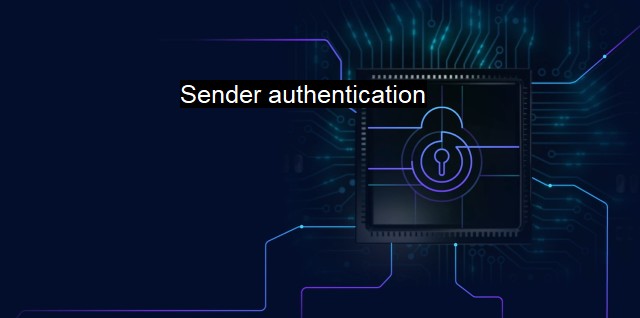What is Sender authentication?
Securing Email Communications: Importance and Methods of Sender Authentication to Avoid Phishing and Fraud
Sender Authentication is a critical component in the domain of cybersecurity and antivirus protection. It is fundamentally crystallizes a mechanism employed to ascertain the integrity of sent data and to confirm the identification of the sender. Sender Authentication is widely utilized in secure computer networking, encrypted email communication, and other scenarios where it is of utmost importance to know whether the information or data received comes from a legitimate source, or a digital imposter, thus placing unquestioned assurance on the integrity of received data.The core rationale behind the usage of Sender Authentication protocols is to thwart malicious cyber activities like phishing, email spamming, and email spoofing. The scheme comes in handy to soundly secure oneself from such breaches by verifying the sender’s identity before opening the message or clicking on any links contained within, thus saving one's system from risking any potential threats.
Sender Authentication tools and protocols serve cybersecurity in multiple ways.Popular forms of Sender Authentication include methods as SPF (Sender Policy Framework), DKIM (DomainKeys Identified Mail), and DMARC (Domain-based Message Authentication, Reporting & Conformance). Each utilizes a unique approach to deter unwarranted intruders from successfully launching their malicious attacks.
For instance, SPF initiates checks on the incoming emails against the sender’s IP address and cross-verifies it with the list of authorized IP addresses to send emails from the specific domain, under consideration. If the verification fails, the email is considered harmful, and appropriate action is taken.
DKIM, on the other hand, associates the email with the sender's domain using a digital signature. This form of authentication adds an encrypted signature in the header of the email that cross-checks the content of the email against the signature added. Any discrepancies between content and signature discern spam or forgery.
DMARC uses a different approach that utilizes both SPF and DKIM. It gives the sender control to define actions applied to emails' failing SPF and DKIM checks and generates actions reports for sender's visibility.
Antivirus software also adopts Sender Authentication to secure users from fraudulent emails carrying malicious attachments or links. A common maneuver of hackers is to guise as a trustworthy source, luring victims to open the infected emails which thus, once deployed in the recipient's system, opens back doors enabling the hackers to illicitly gain access, deploy malware, or extract critical information.
Therefore, Sender Authentication plays a consistently crucial role in the cybersecurity framework. They form invaluable tools used in conjunction with antivirus solutions to provide secure environments for data exchange, preserving confidential information's integrity and content while protecting systems against potential breaches.
Digitally interconnected networks, today, constitute an incredibly hazardous space marked with continual evolving threats in various shades. Hence, the significance of cybersecurity cemented with tools like Sender Authentication increases multifold. Indeed, it remains undefeatable in the context of electronic communication, preventing illicit entities' activities while ensuring legitimate ones aren't blocked. Implementation of Sender Authentication involves technical acuity and a solid understanding of both the protocols and the individual business needs to which they'll cater. Herein lies and rotates the key to effective, robust cybersecurity holding down a vital frontier in the ceaseless struggle fought between data protection and cybercrime.

Sender authentication FAQs
What is sender authentication and why is it important in cybersecurity?
Sender authentication is the process of verifying that an email or other online communication actually came from the purported sender. This is important in cybersecurity because it helps prevent spoofing and phishing attacks, which can trick users into unwittingly sharing sensitive information or downloading malware.What are some common methods of sender authentication?
Common methods of sender authentication include DKIM (DomainKeys Identified Mail), SPF (Sender Policy Framework), and DMARC (Domain-based Message Authentication, Reporting, and Conformance). These protocols use various cryptographic techniques to verify that an email message originated from the domain it claims to be from, and that it has not been tampered with during transit.How do antivirus programs use sender authentication to protect against malware?
Antivirus programs may use sender authentication as part of their threat detection and prevention strategies. By verifying that an email or other communication actually comes from a trustworthy source, the antivirus software can help prevent users from inadvertently downloading malware or other malicious code. The software may also analyze other factors, such as the content of the message and the behavior of the sender, to assess the overall risk level and determine whether to block or allow the communication.What are some best practices for implementing sender authentication in a cybersecurity strategy?
Some best practices for implementing sender authentication include configuring SPF, DKIM, and DMARC protocols on all outgoing email, regularly monitoring for unauthorized use of email domains or addresses, and educating employees and users about the importance of verifying the authenticity of online communications. It is also important to regularly update and patch antivirus software and other security tools to stay ahead of evolving threats.| | A | | | B | | | C | | | D | | | E | | | F | | | G | | | H | | | I | | | J | | | K | | | L | | | M | |
| | N | | | O | | | P | | | Q | | | R | | | S | | | T | | | U | | | V | | | W | | | X | | | Y | | | Z | |
| | 1 | | | 2 | | | 3 | | | 4 | | | 7 | | | 8 | | |||||||